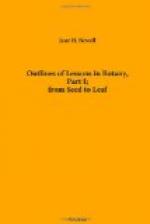[Footnote 1: These buds cannot be satisfactorily examined in cross section, on account of the resin. The scales must be removed one by one, with a knife, with a complete disregard of the effect upon the hands.]
The leaf-scars are somewhat three-lobed on the young parts, with three dots, indicating the fibro-vascular bundles, which ran up into the leaf. The scars are swollen, making the young branches exceedingly rough. In the older parts the scars become less noticeable. Strong young shoots, especially those which come up from the root, are strongly angled, with three ridges running up into each leaf-scar, making them almost club-shaped. There are often from twenty to thirty leaves in one year’s growth, in such shoots, and all the leaves are not rudimentary in the bud. The growth in this case is said to be indefinite. Usually in trees with scaly buds the plan of the whole year’s growth is laid down in the bud, and the term definite is applied. Branches, like the Rose, that go on growing all summer grow indefinitely.
The bud-scale scar is quite different from the other trees which we have examined. It is not composed of definite rings, but of leaf-scars with long ridges running from each side of them, showing the scales to be modified stipules. The leaf-scars have become somewhat separated by the growth of the internodes. In the Beech, there are eight, or more, pairs of scales with no leaves, so that the internodes do not develop, and a ring is left on the branch.
The flower-cluster leaves a concave, semicircular scar, in the leaf-axil.
[Illustration: FIG. 17.—Balm-of-Gilead. 1. Branch in winter state: a, leaf-scar; b, bud-scar. 2. Branch, with leaf-buds expanded. 3. Branch, with catkin appearing from the bud.]
The terminal buds are the strongest and not very many axillary buds develop, so that the tree has not fine spray.
The leaf-arrangement is alternate, on the 2/5 plan. Phyllotaxy is not yet to be taken up, but the pupils should be shown the different angles of the branching of the twigs, and told to compare them with Beech and Elm.
QUESTIONS ON THE BALM OF GILEAD.
In which buds are the flower-clusters?
Are there flowers and leaves in the same buds?
What are the scales of the bud?
How are the leaves folded in the bud?
How do the axillary and terminal buds differ?
What are the dots on the leaf-scars?
Why is there no distinct band of rings as in Beech?
How old is your branch?
Where do you look for flower-cluster scars?
Which buds are the strongest?
How does this affect the appearance of the tree?
What makes the ends of the branches so rough?
Compare the arrangement of the twigs and branches
with Beech and Elm, with
Horsechestnut and Lilac.
TULIP-TREE (Liriodendron Tulipifera).




